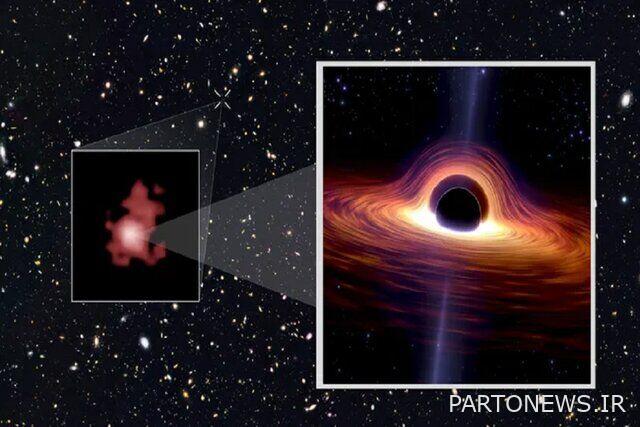The oldest black hole in history was discovered

According to the report of Economy Online, quoted by ISNA, This black hole, which formed just 400 million years after the Big Bang, could help explain how massive black holes grow so quickly.
According to Space, a group of astronomers used the James Webb Space Telescope (JWST) to discover the most distant and oldest black hole ever seen.
This discovery could be a major step forward in understanding how supermassive black holes reached masses equivalent to millions of billions of times the mass of the Sun in the early universe.
The black hole is located in the ancient galaxy GN-z11, which is 13.4 billion light-years away and therefore appears to have existed only 400 million years after the Big Bang. The black hole itself is about 6 million times the mass of the Sun, and appears to be feeding on material from the surrounding galaxy five times faster than current theories hold it to be stable.
In a statement, Cambridge University’s Department of Physics and lead researcher Roberto Maiolino described the discovery as a “great leap forward” for black hole science.
Maiolino said in this statement: “It is too early to see such a black hole with this mass in the universe, so we need to consider other ways that these black holes may form.” Very early galaxies were very rich in gas, so they acted like a buffet for black holes.
Are massive black holes gluttons?
The size of primordial supermassive black holes when the universe is less than a billion years old poses a problem for formation theories, because it would take billions of years of continuous feeding to reach masses of millions or billions of times the mass of the Sun.
“It’s like seeing a family walking down the street, and they have two 6-foot-tall (1.8-meter) teenagers, but a toddler who’s tall,” said John Reagan, a researcher at the University of Minot who was not involved in the study. They also have a 6-footer with them. This is a bit problematic; How did a toddler get so tall? And this is the same for massive black holes in the universe. How did they get so big so fast?
Scientists currently consider two main paths that black holes could take to reach such mass in the early universe. They can start as tiny black hole seeds that form when massive stars collapse at the end of their lives after millions or billions of years, or they can skip this stage entirely.
This can happen if huge clouds of cold gas and dust collapse and immediately form a supermassive black hole seed with a mass several million times that of the Sun. As such, this process fast-tracks millions or billions of years of stellar evolution and gives a strong start to the feeding processes of stellar mergers that help black hole seeds grow into supermassive black holes. The discovery of this new ancient black hole with a mass of several million times the sun is in favor of this theory.
However, on the other hand, the rate at which this black hole in GN-z11 is accreting matter could indicate that black holes may be feeding faster than other black holes discovered in the early universe. This could pave the way for seed theories of small black holes.
A mathematical formula called the Eddington limit shows how fast an object, such as a star, can accumulate mass without the radiation it emits, or its luminosity, destroying the mass and thus ceasing to store food.
While black holes do not emit light because they are bounded by a boundary line called the event horizon, their massive gravitational influence causes the material orbiting around them to violently disintegrate and heat up, emitting radiation in the process. The faster the black hole is fed, the more intense the light from the region called the active galactic nucleus (AGN).
Therefore, the Eddington limit applies in this region and can act similarly to eject matter and cut off black hole feeding.
This newly discovered black hole is accreting matter from its host galaxy at a rate five times faster than the Eddington limit. Periods of so-called “severe Eddington enhancement” may occur but do so for limited periods.
The team estimated that if this period of feeding had continued for the black hole for 100 million years, it might not have started life as a supermassive black hole seed. This black hole could have formed from a very light stellar-mass black hole seed between 250 and 370 million years after the Big Bang and quickly reached the mass observed by James Webb.
Feeding a black hole may destroy its host galaxy
What the team is relatively confident of is that the black hole is responsible for the intense feeding of GN-z11 itself, which is about 100 times smaller than the Milky Way and very bright.
But this gluttonous black hole will probably stop the growth of its host galaxy as well.
The superfast winds of particles that feed from around the black hole are likely to remove gas and dust from the heart of the galaxy. Cold clouds of gas and dust collide with the newborn stars, and so this means that the black hole is grinding away the birth of a star, destroying the growth of this small galaxy in the process.
In addition to learning more about this black hole and its galaxy, the team behind the research believes that James Webb’s power should help discover more black holes in the early universe.
Specifically, they seek to discover tiny black hole seeds in the infancy of the universe.
The team’s research was published on Wednesday, January 17, in the journal Nature.

